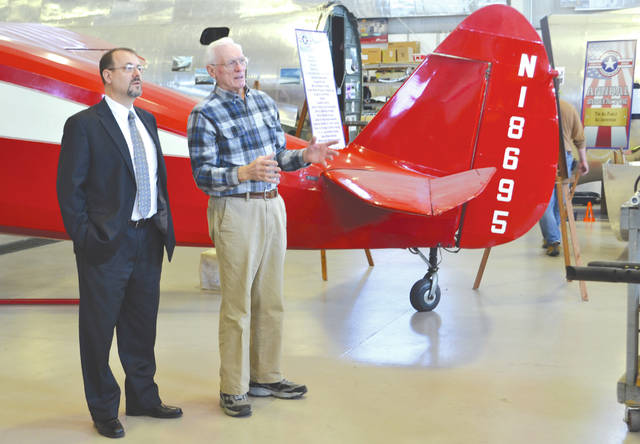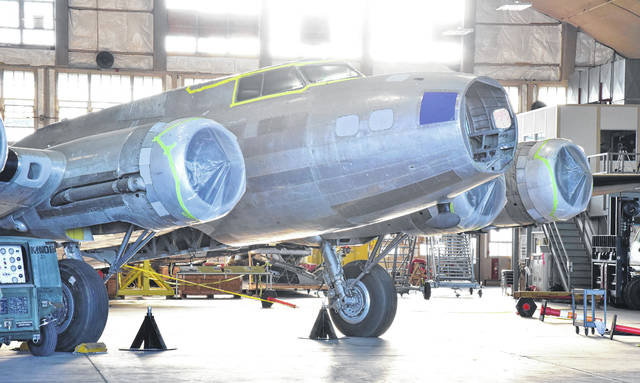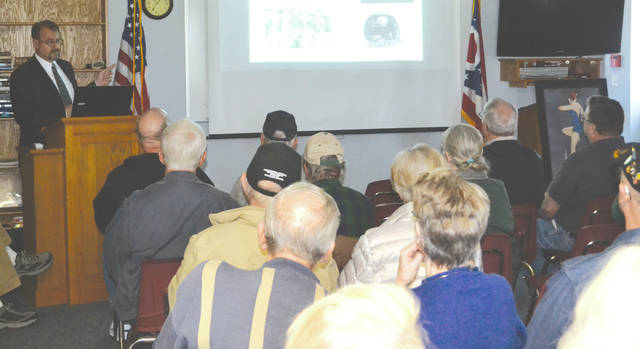


Memphis Belle fever is building as the days count down to unveiling events in Dayton and related events in Urbana.
Jeff Duford, curator of the National Museum of the U.S. Air Force, Dayton, presented a lecture on the ongoing restoration of the Memphis Belle at the Champaign Aviation Museum on April 26. Over 60 people attended the slide-show presentation about the World War II aircraft, which will be officially unveiled on May 17 with celebrations at both the National Museum and Grimes Field.
“The Memphis Belle is not only famous, it is important, and most importantly it is an American icon,” Duford said. “It’s not that it was the first of something. It’s that it has become identified as the symbol of the heavy bomber crews and also the heavy bomber campaign … It’s another one of those artifacts that embody who we are as a people and how far we will go to defend freedom.”
During the lecture, Duford touched on the history of the airplane and its crew, the process of its restoration and the events surrounding the opening of the exhibit.
History
The Memphis Belle was a B-17 in the Eighth Air Force during WWII. It was damaged seven times over its combat tour and eventually completed 25 missions. However, according to Duford it is a myth to say the Belle was the first aircraft to complete 25 missions.
“Just like any historical myth, and especially events that have lots of myths, the true story is so much more interesting and fascinating,” he said. “The Memphis Belle’s first is that the Memphis Belle was the first U.S. Army Air Force heavy bomber to return to the U.S. after finishing 25 missions over Europe. There were numerous newspaper articles and newsreels all across the country, so when they returned in June of 1943 they went on a war bond tour, and they were essentially the rock stars of their day. Every American knew what the Memphis Belle was, and they knew the names of the crew members.”
The Memphis Belle war bond tour stopped at over 30 locations around the country drumming up support for the heavy bomber campaign, which was experiencing serious setbacks and heavy casualties. According to Duford, they also went to airplane factories to help encourage the workers, and to bases where they told bomber crewmen that it was possible to survive their tour.
“America conducted a campaign that was unique and different,” Duford said. “It was heavy bombers flying during the day using the Norden bomb site, which for the time was precise – not in today’s terms – and to try to destroy the enemy’s ability to continue to fight by eliminating their oil production, eliminating their tank production, plane production, so on and so forth and wrecking their infrastructure. That was something that at the time was unproven; no one knew if that would be successful or not, and we committed an enormous amount of national resources and people to the strategic bombing campaign. Well, in the end it was successful at a very high cost.”
A year after the Belle returned to the states, the U.S. War Department produced a 45-minute documentary called “Memphis Belle: the story of a flying fortress,” which Duford said cemented its fame. He also said that when President Franklin Roosevelt screened the film he said words to the effect that every American needs to see this movie, words which Duford says continue to be true.
A hastily printed information booklet about the crew the month after they came back solidified some of the myths about the Belle, Duford added. Although the crew did not fly all of its missions on the Belle and although the Belle was not the first heavy bomber to fly 25 missions, Duford maintains that it was instrumental in demonstrating the decisive use of air power and led to the Air Force becoming a separate service from the Army in 1947.
Restoration at museum
Following the war bond tour, the Memphis Belle was used as a training plane in Florida, then went to Altus Army Air Field in Oklahoma at the end of the war. Duford said there is a good chance the plane would have been scrapped there had the city of Memphis not requested to display the plane in 1946.
“It then sat outside for a few years and then was put on top of a concrete pedestal in the National Guard armory and sat outside for about 27 years,” he said. “It was subjected to vandalism and it was subjected to the weather. However, at this same time at the Air Force Museum … most of the collection was outside. A lot of museums at the time didn’t have the resources that we have now, so airplanes sat outside.”
Duford said that the airplane deteriorated and instruments were stolen, but in the late 1970s a group was formed called the Memphis Belle Memorial Association to restore the aircraft. The city worked to restore the Belle through the 1980s, but in the late 1990s it became evident that a full restoration was necessary.
“The National Museum of the Air Force gave the MBMA a challenge: show us that you can fully restore the aircraft and that you can properly display it in an appropriate facility,” Duford said. “To their credit they did a study, and as they were going through the study they honestly and ethically said there just wasn’t the financial support in Memphis to do this properly. It was a mutual agreement that the airplane was on loan to Memphis, and they said to come down and bring the aircraft to Dayton. Since then, they have been incredibly supportive.”
The Memphis Belle arrived at the Air Force Museum in October 2005 along with a significant amount of photographic and historical archive material that Memphis transferred there. Duford said the first priority of the museum was to fully disassemble the aircraft so it could be stripped of all the paint and corrosion could be assessed corrosion. He said the labor was intense because many of the surfaces were not flat.
During this time, crews at the museum documented name carvings in the skin of the plane. Enthusiasts had made the carvings during the war bond tour. Those names are all identified and available in a database at the museum.
Duford researched archives of the Air Force Historical Research Agency and documented every route the plane had taken, attacks endured and the types of German aircraft that did the attacking. He learned that 54 airmen received at least one accreditation on the Memphis Belle in combat. Several members of the crew switched in and out, but although the crew did not fly all of their missions together on the Belle they did fly most of their missions together and most of them on the Memphis Belle.
He learned that although the crew of the Belle flew its 25th mission on May 17, 1943, the plane itself flew its 25th mission two days later, with an entirely different crew, to Kiel, Germany.
“For the life of me, I don’t understand why they risked that airplane, because they had their crew and their airplane that they were going to send back to the states,” Duford said. “The first airplane picked for this war bond tour was not the Memphis Belle. It was an airplane called Invasion II that was shot down over Bremen the month before. If that airplane hadn’t been shot down, I wouldn’t be standing here and there would be no Memphis Belle. It probably would have been shot down.”
Among the most useful pieces of evidence involved in restoring the Belle were outtakes from the 1944 documentary that showed museum officials exactly what the exterior of the plane looked like at various times from just after the plane’s final combat mission until finishing the war bond tour. Because the plane was altered with publicity markings, Duford said, he had a choice to make about whether to display the plane as a combat aircraft or as it looked on the tour. He decided to preserve the history of the combat aircraft, but to display the publicity markings elsewhere in the exhibit.
“It’s important to point out that the exterior of the Memphis Belle is 100 percent complete, but restoration of the interior continues and will continue while it’s on site,” he said. “We made a conscious decision that we’re not going to rush the restoration for an opening. A lot of the nose is done, the bomb bay is done, the control panel, the instrument panel is in, but there’s still a lot of work that needs to be done.”
Future changes will involve the installation of sound insulation, which Duford estimates will take a couple years to finish. Once the interior is complete, he plans to take 360-degree photos of the cockpit for display on the museum’s website.
Exhibit
Duford explained that the museum has committed to telling the full story of the heavy bomber crews, and so the Memphis Belle exhibit will be surrounded by an exhibit about the Army Air Force’s strategic bombing campaign. The Belle itself was deliberately placed in the corner of the WWII gallery so that it is visible upon entry, and its exhibit contains artifacts from seven of the crew members, including flight suits, boots, the pilot wings of Robert Morgan and the diary of co-pilot James Verinis.
“What’s really wonderful is all of these artifacts will be displayed literally in the shadow of the Memphis Belle,” said Duford. “They will be right with the Memphis Belle. So these things that have not been together for 75 years will be displayed together at the Air Force’s National Museum in perpetuity, long after we’re all gone.
“It’s really wonderful to bring these things together, and the exhibit will very much show the personal side of the crewmen,” he continued. “Sometimes with these historical events people seem larger than life, like they don’t have the challenges and foibles and weaknesses of the average human being. They’re somehow these towering figures, but these were kids. They were between 19 and 26 years old, and they got inside those aluminum coffins … they knew the danger they were facing. When they were flying in combat the odds of surviving were one in four, and they knew that.”
The exhibit will include two videos using outtake footage, much of which has never been displayed to the public. There will be several turrets displayed separately, as well as a three-minute animated bombing map that shows the campaign.
Unveiling
The Memphis Belle exhibit will open on May 17 at the U.S. Air Force Museum in Dayton, 75 years to the day that the Memphis Belle crew completed its 25th mission, and it will last three days, ending 75 years to the day that the Memphis Belle plane completed its 25th mission. Festivities will include reenactors, a movie festival, and crowds of visitors from across the country and Europe that Duford anticipates will be larger than any numbers the museum has seen before.
Two planes will be staged at Grimes Field on May 14-16 in preparation for the unveiling ceremony at the U.S. Air Force Museum. At Grimes will be the Yankee Lady and the Memphis Belle movie plane, a B-17 model G reverted back to look like a model F for the 1990 movie “The Memphis Belle.” Both planes are expected to provide rides for about $450 per person, estimated to include about a half hour in the air for 10-12 people at a time. Contact information is available at www.champaignaviationmuseum.org to reserve ride times.
According to Champaign Aviation Museum volunteer Bill Albers, on the morning of May 16 a third B-17, the Aluminum Overcast, will make a low pass over the field. It will then be joined by the two B-17s at Grimes Field, five P-51 Mustangs also staged at the field, and a sixth P-51 joining from Marysville. They will proceed to the Air Force Museum in preparation for the unveiling ceremony on May 17.
“I hope that everyone gets a chance to come out at least for one day,” said Duford of the U.S. Air Force Museum event. “There will never be anything like this again at the museum, ever.”




